For effective natural screening, choose flowering hedges based on your privacy needs. Compact varieties like Dwarf Butterfly Bush (2-3 feet) work for partial privacy, while mid-range options like Limelight Hydrangea reach 8 feet. For maximum seclusion, consider Rose of Sharon (10-16 feet). Allow 3-4 feet between plants for proper air circulation, and consider growth rates when planning. Fast-growing shrubs like Forsythia create privacy quicker, while proper maintenance guarantees your living boundary thrives beautifully.
Understanding Mature Height Requirements for Complete Privacy
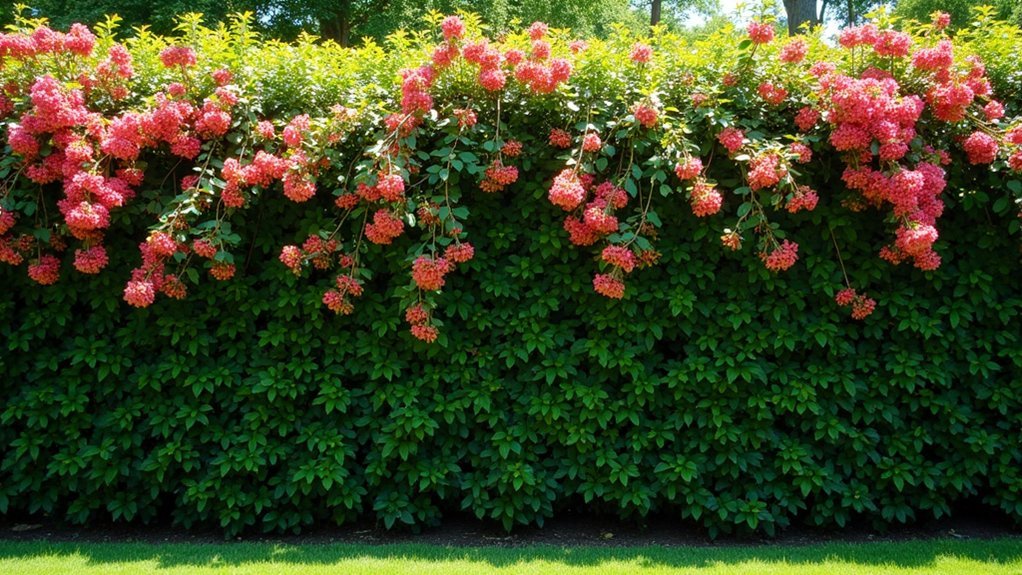
When planning a flowering hedge for privacy, you’ll need to carefully consider the mature height of your chosen shrubs. For complete privacy, look for varieties that reach 6-10 feet tall, such as Forsythia and Ninebark, which create effective dense barriers while offering seasonal blooms.
If you need more substantial screening, Rose of Sharon can grow 10-16 feet tall, making it perfect for smaller yards requiring vertical screening hedge solutions.
Mid-range options like Limelight Hydrangea and Bridalwreath Spirea, reaching about 8 feet, provide solid privacy screens with decorative flowering appeal.
Don’t forget to account for mature width when spacing your privacy screen plants. Even shorter options like Dwarf Crape Myrtle (5 feet) can be effective when layered with taller species to create an uninterrupted flowering hedge that maintains your privacy year-round.
Small-Space Solutions: Compact Flowering Hedges Under 6 Feet
Limited garden space doesn’t mean you have to sacrifice beauty or functionality in your landscape design. Compact flowering hedges under 6 feet offer perfect solutions for small spaces while providing visual appeal and partial privacy.
Small spaces can shine with compact flowering hedges that deliver both beauty and function while creating semi-private garden sanctuaries.
Consider Dwarf Butterfly Bush, reaching just 2-2.5 feet with fragrant blooms that attract pollinators from midsummer through fall.
For non-stop blooms, Spirea ‘Double Play Doozie’ grows 2-3 feet and features stunning red spring foliage.
Low-maintenance options include Landscape Rose ‘At Last,’ growing 3 feet tall with sweetly perfumed flowers until frost.
Need a privacy screen? Dwarf Panicle Hydrangea ‘Little Lime’ reaches 3-5 feet with lime-green summer panicles.
For incredible fragrance, try Koreanspice Viburnum ‘Spice Baby,’ which grows 3.5-5 feet and produces gardenia-like scented spring blooms.
Mid-Range Privacy Screens: 7-12 Foot Flowering Shrub Options
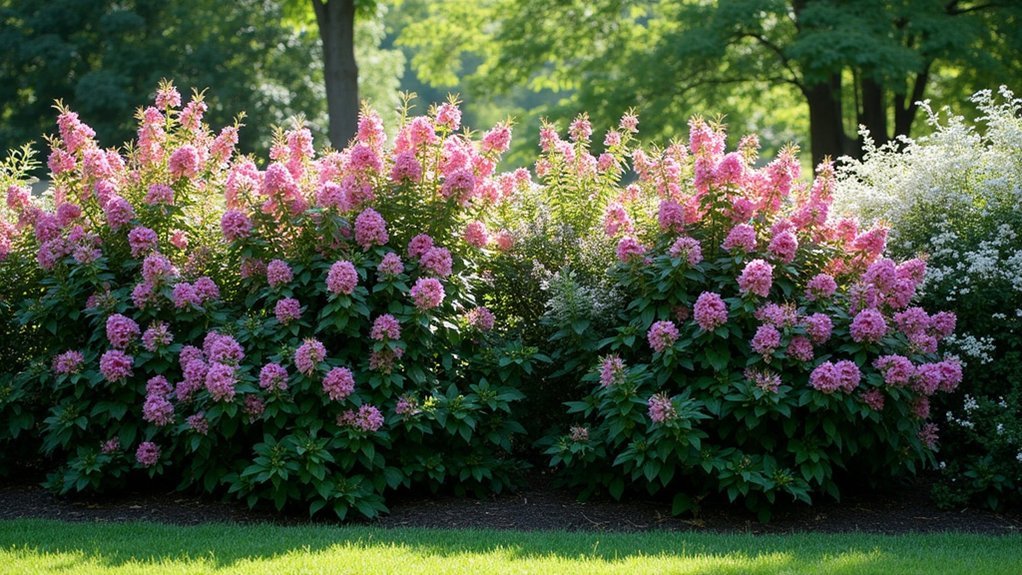
Creating the perfect balance between privacy and beauty, mid-range flowering hedges offer an ideal solution for homeowners seeking substantial screening without the overwhelming presence of taller options. These 7-12 foot shrubs provide effective screens while enhancing your landscape with seasonal interest.
| Shrub Variety | Height | Notable Features |
|---|---|---|
| Limelight Hydrangea | 8 feet | Summer-to-fall blooms |
| Ninebark | 8 feet | Colorful foliage, exfoliating bark |
| Bridalwreath Spirea | 8 feet | Abundant white flowers in mid-spring |
| Forsythia | 10 feet | Bright golden early spring blooms |
| Purple Pillar Rose of Sharon | 10-16 feet | Narrow 2-3 foot footprint for small yards |
You’ll find these mid-range flowering shrubs particularly valuable when you need substantial privacy without sacrificing curb appeal. Their varied blooming seasons guarantee year-round interest while their dense growth patterns create reliable screening.
Towering Beauties: Tall Flowering Hedges for Maximum Seclusion
For homeowners seeking complete privacy without sacrificing beauty, tall flowering hedges offer an unmatched combination of height and visual appeal.
Privacy and beauty coexist perfectly in tall flowering hedges, offering the ultimate solution for homeowners who want both.
When you’re looking for maximum screening, consider these towering options that provide dense coverage while enhancing your landscape with stunning foliage and blooms.
- Japanese Blueberry – Reaching an impressive 40-60 feet tall, this evergreen creates a substantial privacy wall with glossy foliage.
- Rose of Sharon (Purple Pillar) – At 10-16 feet tall but only 2-3 feet wide, this flowering shrub maximizes seclusion in tight spaces.
- Yaupon Holly ‘Scarlet’s Peak’ – Growing to 20 feet tall while maintaining a slim 3-foot width, this versatile hedge thrives in various conditions.
For seasonal interest, don’t overlook Limelight and Fire Light hydrangeas, which offer 6-8 feet of dense screening with dramatic, color-changing blooms.
Width Considerations: Space Planning for Mature Hedge Spread
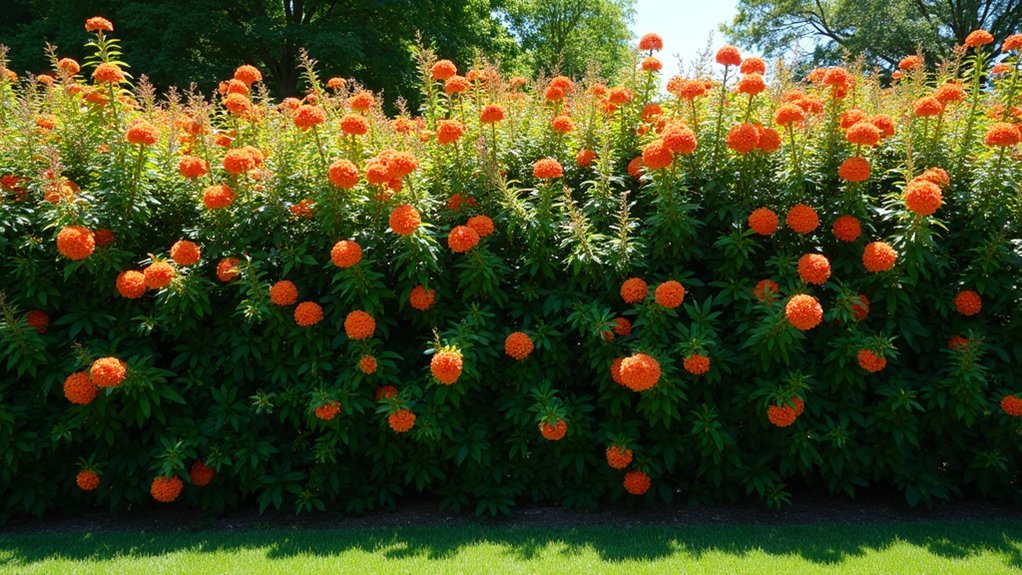
When planning your flowering hedge, you’ll need to measure the distance between your intended planting area and nearby structures, allowing for the mature width of your chosen shrubs plus at least 2-3 feet of clearance.
Assess the growth pattern of each species, considering whether they spread upright, outward, or in irregular shapes that might require additional space beyond their stated mature width.
For denser privacy screens, you can implement multi-row planting, but be sure to increase spacing between rows to 4-6 feet, providing adequate room for root development and preventing future overcrowding.
Proximity to Structures
Although flowering hedges enhance your property’s aesthetic value, they require thoughtful spacing from structures to accommodate their mature spread.
When planning your privacy hedge, consider that most flowering shrubs need 3-4 feet between plants for proper air circulation and healthy growth.
Your hedge’s proximity to structures should account for mature width, which varies considerably:
- Standard flowering shrubs may spread 2-8 feet wide, requiring appropriate distance from walls and fences.
- Compact varieties, ideal for tighter spaces, typically reach only 2-4 feet in width.
- Taller specimens like Rose of Sharon (10-16 feet tall but only 2-3 feet wide) need placement that won’t block light or views.
Choose shrubs that thrive in full sun to part shade based on your specific location’s conditions.
Growth Pattern Assessment
Understanding your hedge’s growth pattern guarantees successful long-term placement and maintenance. When selecting flowering hedges, assess each plant’s mature width—typically ranging from 2 to 10 feet—to determine proper spacing.
For dense privacy screens using shrubs that reach 5-6 feet wide, position plants 2-3 feet apart. If you prefer a more natural appearance with visible individual blooms, opt for medium spacing of 3-4 feet between plants.
Never underestimate the importance of adequate air circulation—crowded plantings invite disease and inhibit flowering. Compact forms like Dwarf Butterfly Bush and Koreanspice Viburnum work wonderfully in limited spaces without sacrificing beauty or function.
These varieties maintain their shape while providing colorful screening options. Remember, your initial spacing decision directly affects your hedge’s health and appearance for years to come.
Multi-Row Planting Space
Multi-row hedge plantings transform ordinary garden boundaries into spectacular flowering displays with remarkable depth and texture.
When planning your privacy screen, consider the mature width of your flowering shrubs—plants that grow 5-6 feet wide should be spaced 3-4 feet apart for ideal density.
For successful multi-row planting space arrangements:
- Stagger rows for an informal look, ensuring each plant receives adequate sunlight while creating visual interest with varying heights.
- Position larger field-grown specimens in the front row for immediate privacy, with smaller plants behind to fill in gradually.
- Maintain 2-3 feet between rows to promote air circulation and healthy growth.
Remember that proper spacing prevents overcrowding while allowing each flowering shrub to reach its full potential, creating a lush, vibrant hedge that provides both beauty and screening.
Layered Screening: Combining Plants of Different Heights and Widths
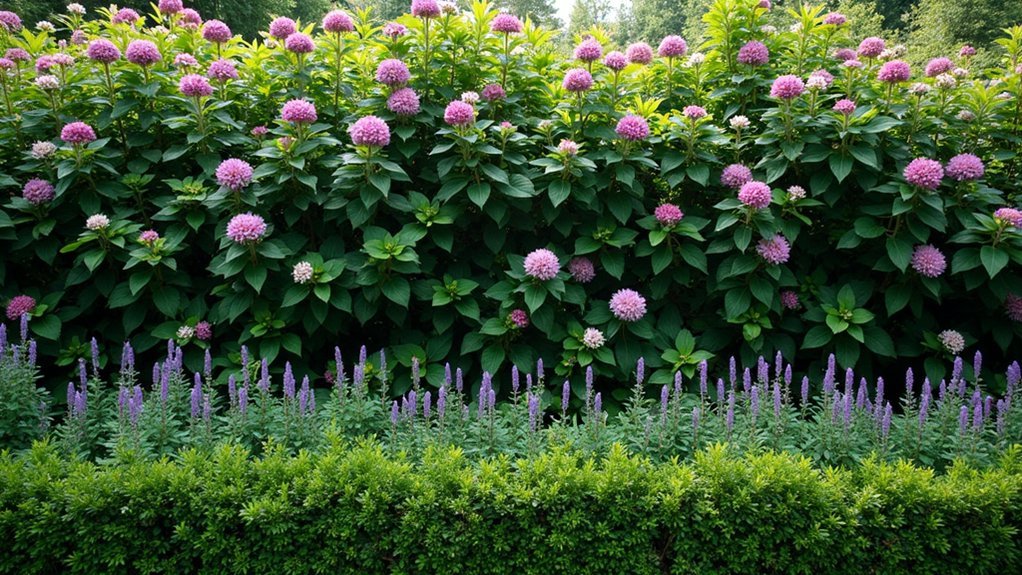
When you’re seeking maximum privacy and visual interest in your landscape, layered screening offers an elegant solution that combines plants of various heights and widths.
Create a tall living screen by positioning towering varieties like Japanese Blueberry (40-60 feet) at the back, with mid-sized options like 12-foot Viburnums in the middle.
For ideal density, pair narrow specimens such as Yaupon Holly ‘Scarlet’s Peak’ (3 feet wide) with broader Japanese Blueberries (20-30 feet wide). This arrangement guarantees each plant receives adequate sunlight in well-drained soil.
Select disease-resistant flowering shrubs like Forsythia and Hydrangeas to incorporate seasonal interest throughout the year while supporting pollinators.
Maintain your privacy screening by regularly pruning each layer to prevent overcrowding while preserving the distinctive, multi-dimensional effect of your living barrier.
Seasonal Dimension Changes: Planning for Growth Patterns
As you design your flowering hedge, you’ll need to anticipate how its dimensions will fluctuate throughout the year and across its lifespan.
Flowering shrubs like Forsythia can reach their full size of 10 feet tall and wide, while others like the Limelight Hydrangea grow to 8 feet in both directions. Understanding these seasonal growth patterns guarantees proper spacing and visual appeal.
Consider these critical factors when planning:
- Mature size – Allow adequate space for plants to reach their maximum dimensions (4-10 feet for most flowering hedges)
- Hedge’s width variations – Account for seasonal expansion, especially during peak growing seasons
- Maintenance and pruning requirements – Regular trimming helps manage plants like Dwarf Butterfly Bush (2-2.5 feet), maintaining their compact size
Creating Sight Lines: Strategic Placement Based on Hedge Dimensions

Strategic placement of flowering hedges creates powerful sight lines that enhance your garden’s visual appeal while providing privacy. When designing your natural screening, consider the mature height and width of each plant to create uniform sight lines. Dense hedges should reach 5-6 feet wide when fully grown for effective screening.
| Spacing Type | Distance Apart | Visual Effect |
|---|---|---|
| Tight Formal | 2-3 feet | Solid barrier |
| Informal | 3-4 feet | Softer boundary |
| Staggered | Varied | Layered depth |
For successful sight lines, pair shrubs of similar height together, like Miss Molly Butterfly Bush (4-5 feet) with comparable varieties. In narrow spaces, choose columnar options like Rose of Sharon ‘Purple Pillar’ that grow tall while staying slim. Implement staggered planting patterns to increase density and visual interest while maintaining appropriate spacing.
Growth Rate Factors: Timeline to Achieve Desired Screening Dimensions
Understanding growth rates is fundamental when planning your flowering hedge, as the timeline to achieve desired screening directly impacts your landscape design strategy.
Fast-growing flowering shrubs like Forsythia can create privacy within just a few years, while slower varieties like Dwarf Fothergilla require more patience.
Your hedge’s development depends on three critical factors:
- Site conditions – ideal growing conditions including soil quality, sunlight exposure, and proper drainage can accelerate growth by 30-50%
- Species selection – varieties like Ninebark achieve 8-foot screening dimensions within 3-5 years
- Planting technique – denser spacing creates faster visual barriers as plants merge together, though at the cost of long-term plant health
Regular maintenance through pruning encourages bushier growth, helping you achieve your desired screening effect sooner.
Frequently Asked Questions
What Is the Best Hedge for Screening?
For screening, you’ll want fast-growing evergreens like Leyland Cypress or Arborvitae that reach 15-20 feet tall. If you’d prefer flowering options, Rose of Sharon and Viburnum create beautiful privacy barriers.
How Much Width Do You Need for a Hedge?
You’ll need a minimum width of 3-5 feet for a standard hedge. For privacy screening, allow 5-6 feet. Consider your shrub’s mature width and plan spacing accordingly—tighter (2-3 feet apart) for formal hedges, wider for flowering varieties.
What Is the Best Plant to Block Neighbors’ Views?
For blocking neighbors’ views, you’ll find Japanese Blueberry most effective at 40-60 feet tall. If you need something narrower, try Yaupon Holly ‘Scarlet’s Peak’ which grows 20-feet tall but only 3-feet wide.
What Is the Fastest Growing Flowering Hedge?
Forsythia is your fastest option, growing up to 10 feet tall in just a few seasons with golden spring blooms. Chaste Tree follows closely, while Spirea and Dwarf Butterfly Bush provide quicker low-growing alternatives.
In Summary
When planning your flowering hedge, you’ll need to match mature dimensions to your privacy needs. Choose smaller varieties for tight spaces, mid-range for standard screening, or tall options for complete seclusion. Don’t forget to account for width, seasonal changes, and growth rates. With careful selection and strategic placement, you’ll create beautiful living screens that provide exactly the privacy you desire.



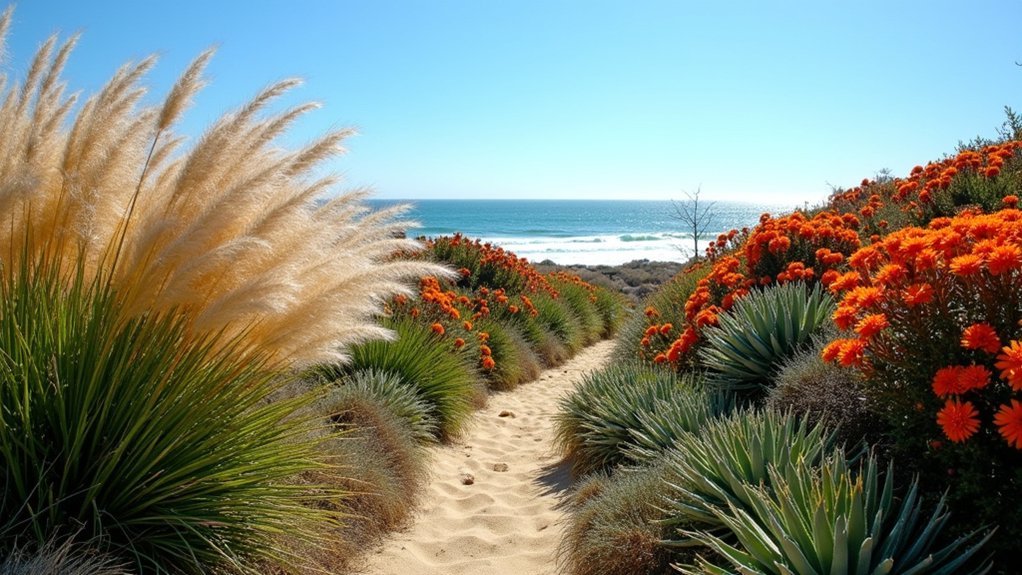
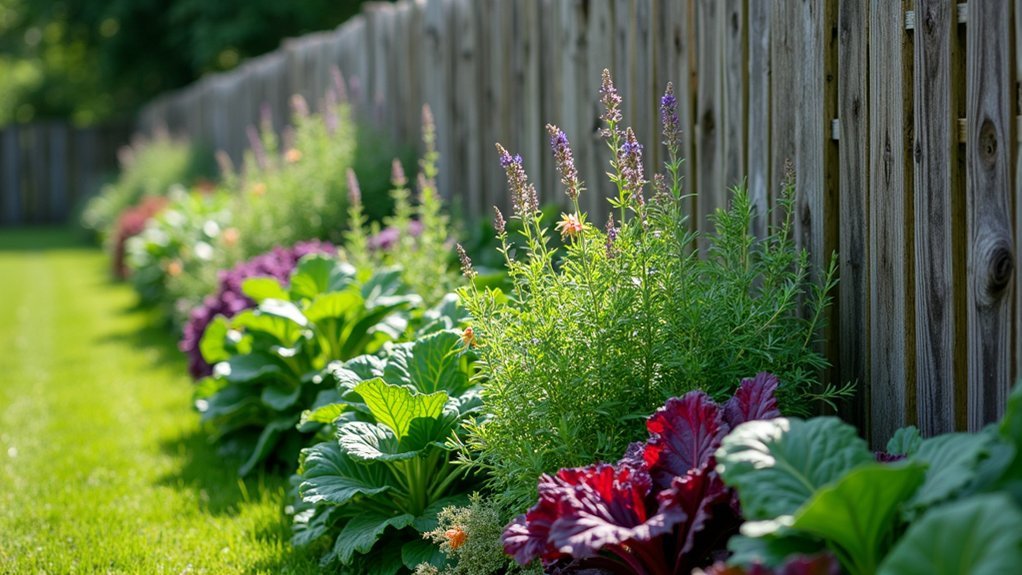
Leave a Reply